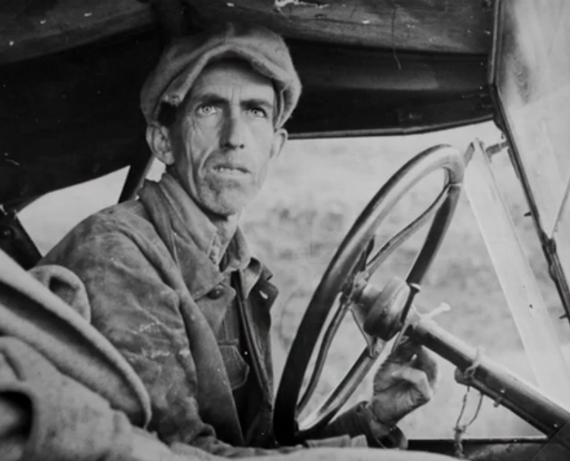You’ve likely seen Dorothea Lange’s most well-known portrait, “The Migrant Mother.” It has become a visual symbol of America’s Great Depression and the plight of farmers-turned-migrant workers fleeing the devastating drought conditions—known as the Dust Bowl—in the country’s Great Plains region.
It’s a photograph that almost never came to be. Lange was driving alone in rural California on a rainy day, not planning to stop and take any photographs, when she passed a sign for a pea farming camp and spontaneously decided to make a u-turn and go back to the camp. That’s where she found Florence Thompson and her children, the subjects of “The Migrant Mother.” The photograph was printed in newspapers and magazines around the country and has become so iconic that Lange herself said, “It doesn’t belong to me anymore. It belongs to the world. She [Florence Thompson], that one picture, belongs to the public, really.”
In this full-length PBS documentary, part of the network’s American Masters series, you can get an insider’s look at 30+ years of Lange’s remarkable, evocative photography:
Lange grew up in New Jersey and New York in the early 1900s. She was keenly observant of her surroundings from a young age, a trait that was encouraged by her grandmother.
Dorothea remembered being mesmerized by clothes fluttering on the line. She looked out at them and said, “These are beautiful!” Her grandmother said to her, “To you, everything is beautiful.”
As a young adult, Lange moved to San Francisco with a friend and got a job in a drugstore developing film—through which she discovered photography as a method of recording her visual experiences. She opened her own portrait studio in 1919 at the age of 24 and became an integral part of the city’s artistic community.
Later, during the Great Depression, she began working with Paul Taylor, a University of California economist, to record the working conditions in California; he would later become her second husband. Lange was subsequently recruited by a new government organization, the Farm Security Administration, to “introduce America to Americans.”
“Lange’s photographs from the 30s are full of hope, not just despair.”
Lange’s photographs from the period show migrant families living in ramshackle shanties and tents, all their earthly belongings piled high on jalopies.
Many of them offer a glimpse into the difficult lives of mothers trying to care for their children with no home, no stability, and no resources. Some of her most celebrated work, including “The Migrant Mother,” came out of this period.
“Lange had an understanding of what she was seeing. She could photograph a shanty, and what she was really photographing was the house that wasn’t there. She could photograph a doorframe, and what she was really photographing was the door that wasn’t there. She could photograph the stovepipe, and what she was really photographing was the hearth that wasn’t there. The reason that Lange saw this so clearly is that she faced a number of her own struggles — she was a working mother on the road.”
Throughout her prolific career, Lange gave a face to some of the worst periods in American history like the Great Depression and the creation of Japanese internment camps, compassionately educating the American public about the often unseen trials of their fellow citizens. She remained active in her work up until her death in the mid-1960s. Her last project was a prestigious one — planning her own solo exhibition at the Museum of Modern Art (MOMA) in New York. She died only three months before the exhibition opened.
“Beauty appears when one feels deeply. Art is an act of total attention.” – Dorothea Lange
Like This Article?
Don't Miss The Next One!
Join over 100,000 photographers of all experience levels who receive our free photography tips and articles to stay current:












Leave a Reply